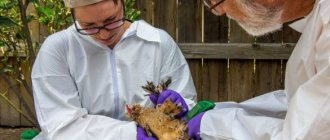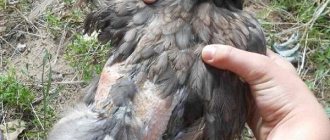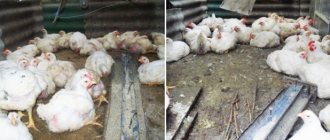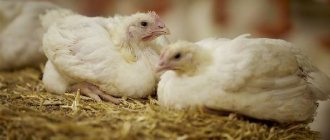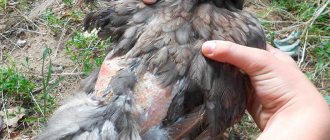1 783
no comments yet
1
Author:
Sadchikov Nikolai Alekseevich.
Reading time: 3 minutes
Delayed physical development of young individuals indicates the presence of some disease in birds. This means that one or a number of conditions for keeping or feeding young chickens have been violated. The danger lies in the fact that the disease can develop and lead to death.
Maintenance of adult broilers
If broilers do not grow well and laying hens produce few eggs, in this case we recommend paying special attention to the living conditions. An adult bird is still growing and requires good conditions to gain weight:
- Lighting for 17 hours a day with infrared lamps of blue or reddish shades. It is not necessary to illuminate for more than the specified time, because bright light irritates birds.
- They are fed at least 4 times a day only with high-quality feed and compound feed. It is necessary to give an admixture of eggshells, vitamins, grass, small pebbles - to improve digestion and rapid growth. Birds definitely need calcium and protein.
- Prevention against parasites and infections. Carry out regularly with high-quality drugs. Sick birds are removed.
- Ventilation and cleaning of premises.
- Regular walking.
Rejected broilers (those with genetic diseases) will not reach standard size in the future. If kept in good conditions, you can get medium-sized chickens, but their development will not be complete.
Diseases such as rickets and vitamin deficiency are very difficult to cure, so the disease should be prevented with the help of preventive measures
It is important to adhere to the rules of feeding chickens, introducing a sufficient amount of vitamins into the diet
Regular examination by a veterinarian is necessary even for healthy livestock. To protect animals from diseases, you can vaccinate or sometimes get tested for parasites. They use traditional methods to accelerate weight gain, but antibiotics and vitamin complexes are more credible.
Features of nutrition of laying chickens
In order for laying chickens to gain weight well, their diet must contain exclusively high-quality feed, which is recommended to be selected taking into account the age of the birds.
From birth, chickens must be fed with starter feed, after a month, buy a juvenile feed, and only then choose food for an adult chicken - finishing feed.
Chickens
What does feeding regimen mean for broilers?
- in the first week, chickens should be fed about eight times a day;
- from two weeks of age, birds should eat about six times a day;
- after three weeks - four times a day.
From birth, chicks should receive a large amount of protein food, for example, cottage cheese, fermented milk, flour (fish or bone), 1-2 g of yeast.
And this is every day. And after a week you can pick some nettles and alfalfa, which is recommended to be included in the mash.
During the second growth period of laying hens, their diet becomes more varied. Now your pets need grass and other types of succulent food compositions. While it is recommended to reduce the amount of food containing protein. It is important to ensure a good drinking regime for chickens. The water must be exceptionally clean and warm.
If birds grow poorly, it is recommended to add eggshells and chalk, crushed shell rock and fine gravel to the chickens’ diet. This will significantly improve your pet's digestion.
Reasons for underweight in broilers
Broilers are indeed significantly larger in size and quantity of meat than ordinary birds. This achievement is due to interbreeding, as a rule, of meat and meat-egg breeds, the end result of which is heterosis, which determines their larger size.
But the specificity of a larger size has its own characteristics. In the case of broilers, this means a greater appetite of the bird and increased requirements for the quality of food and its saturation with protein - the main building material for the muscles of the broiler.
Reason 1 – poor nutrition
The first and main reason for underweight in broilers is unbalanced nutrition, especially in the area of saturation of their food mixture with proteins.
The desire to save money and feed the bird with a cheap or low-quality mixture with low protein content can backfire on the owner or housewife. This method of saving on poultry in the case of broilers is unacceptable. After all, it is the high saturation of the feed with proteins and vitamins that can trigger the rapid growth of muscle mass in broilers. Violation of this condition is the production of weak poultry with low weight.
The recommendations are as follows: in the initial period of breeding a newly born broiler, when the weight of the chick is still around 40 grams, start feeding it with special pre-launch food.
In the first 7 days, feed the chicks 8 times a day.
In addition, introducing a combination of sprouted grains and green feed into the chicks' feed will give it an excellent start for development and growth. This is an excellent solution when there is a lack of funds to purchase special vitamin complexes.
This solution will be useful both for the proper development of the bird’s musculoskeletal corset and will allow the digestive system of a small boiler to be optimally prepared for the complete digestion of food and the extraction of the maximum amount of useful substances from it.
These are two very important factors at the beginning of the development of broiler chicks: the ability of its skeletal system to withstand the load from the large weight of meat on the carcass and the ability of the digestive system to absorb all the useful elements of food.
Further, when the chick reaches a weight of around 200 grams and further, it is necessary to saturate the food with phosphorus by introducing fish meal, increase the proportion of green food to improve digestion and introduce carrots and potatoes into its diet.
A sufficient amount of protein in the feed can be achieved by introducing high-quality feed into it. A small amount of a special fine stone in the food will also help him improve his intestinal function. At this stage, vitamin supplements will be appropriate and will have a beneficial effect.
Reason 2 – conditions of detention and walking
In addition to high-quality food rich in protein and useful minerals, the bird needs a certain maintenance order. With a lack or excess of key decisions in the content, such an unpleasant phenomenon as underweight of the broiler can be observed.
To gain full weight, broilers should not be allowed to become overly active. This can be avoided by keeping them closed (using cages). It is imperative to provide them with good room illumination and excellent ventilation under this maintenance regime. These are the necessary conditions for a healthy bird:
Reason 3 – poultry diseases and ailments
Poor living conditions, lack of sunlight and clean air, low-quality food with low protein content - all these are factors that greatly weaken the bird, making its immunity unable to cope with diseases.
The lack of attention of the owners to the health of the bird will naturally be punished by its low weight and poor appearance, and the very low quality of the meat obtained from the bird after slaughter.
Check your poultry regularly for worms. If this moment is missed, your bird is at risk of becoming infected with helminths. Cappilariasis is the name of your problem.
If there are an unnaturally large number of helminths, the bird will simply die. If it is moderate, you will be weak, have low weight and low immunity.
The solution to the problem is regular examination by a veterinarian, timely vaccination of your livestock and stimulation of the bird’s own immunity with a high content of vitamins in the feed.
When poultry becomes infected, antibiotics must be used.
Do chickens peck eggs? This may be a consequence of poor nutrition! For more details, check out our article.
Do you dream of having small ornamental chickens? Then our material will be useful to you.
Broilers do not eat well: what to do
Broiler chickens are hybrids obtained by interbreeding. Their main advantage is early maturity. Over 7 weeks of life, chickens gain 2.5 kg, by 2 months they weigh about 3 kg, and by 3 months - 4-5 kg. Broilers are slaughtered at approximately 75-80 days. Keeping animals longer is unprofitable, since weight gain practically stops, but they will consume even more food.
Important! The main criteria for assessing the maturity of broiler muscle mass are the breast and thighs. With their sufficient and proportional development, slaughter can be carried out.
Consequences of overpopulation
The problem began to be discussed in the last decades of the 20th century. At the beginning of the millennium, no more than 100 million people lived on the planet. The growth in numbers was restrained by constant wars, a terrible epidemic situation, and the lack of normal medicine. Only in the 1800s did the number of people on the planet exceed 1 billion. And in the 20th century, they started talking seriously about the possibility of overpopulation of the Earth, as population growth became exponential. This became possible thanks to technological progress, as well as an increase in living standards.
Scientists call the situation that has developed in recent decades a demographic explosion. However, the population is growing at a crazy pace not in developed countries (where the population is supported by longevity, and there is another problem - the progressive aging of the nation), but in the underdeveloped countries of Asia and Africa, where the birth rate significantly outstrips the development of the economy and social sphere.
The consequences of overpopulation can be the following problems:
- Drinking water shortage. The problem, which is pressing for many countries today, is getting worse every year. In Africa, people die from dehydration and diseases caused by poor quality water.
- Lack of food resources. In many overpopulated regions, up to 25% of people suffer from hunger or poor nutrition, causing illness and death. Underdeveloped countries cannot provide their growing population with food due to the lack of acceptable agricultural technologies, shortage of fertile land, and unfavorable climatic conditions. In addition, the vast majority of residents are unemployed.
- Increasing food costs. A growing population needs more food. We have to expand the acreage, build more livestock farms, and increase the plantings of vegetables, cereals, fodder and other crops. But the expansion of agricultural land cannot continue indefinitely. Moreover, due to the environmental situation, there is a tendency to reduce arable areas.
- Reduced availability of fuel and energy. Fuel resources are exhaustible. A reduction in their use is required, but in conditions of population growth this is problematic. Developed countries are actively developing alternative inexhaustible energy sources, but so far this is a drop in the bucket.
- Deterioration of the environmental situation. Humanity causes enormous damage to nature, taking away resources, destroying ecosystems, poisoning the atmosphere and hydrosphere. As the population grows, the negative impact increases. Many countries (for example, overpopulated China), expanding industrial production, do not care about the environment, bringing it to a catastrophic state.
- Excess labor force. With the development of technology and technology, human physical forces in production are becoming less in demand. This leads not only to a decrease in wages, but also to an increase in the number of unemployed.
Independent problem solving
If the veterinarian has not identified signs of disease in meat crosses, you should look for a solution to the problem yourself. The living conditions of the bird should be reconsidered and densely stocked premises should be resettled
Particular attention should be paid to the daily diet of broilers; it is recommended to add:
- Substances containing calcium (crushed chalk, eggshells, ground shells).
- Fresh grass and greens. This naturally occurring supplement contains almost all essential vitamins.
- Compound feed. At the beginning, the compound feed should be mixed with wet food; as the bird grows older, it can be completely switched to the combined feed.
Combined feeds recommended by veterinarians are better absorbed by broilers. Thanks to its optimal composition, feeding exclusively with mixed feed will help avoid digestive problems. From the age of two months, young animals can be completely transferred to mixed feed. If the breeder does not have a specialized combined feed, experts recommend mixing the necessary additives yourself: fish oil (from the first days of life), bone meal (for three-day-old chickens), crushed chalk and shells (for five-day-old broilers).
Why do turkeys fall and land on their feet?
2.1
Prevention and proper arrangement of the poultry house
If young broilers cannot stand on their feet, their legs move apart and the bird's legs fail, immediate action should be taken. Experts recommend adhering to a number of rules to ensure normal development of meat crosses. To do this you need:
- comply with all density standards when relocating birds;
- maintain the required temperature conditions;
- regularly maintain cleanliness in the area where birds live;
- equip the room with ventilation systems and proper lighting.
It is necessary to clean the room from feathers and feces once every seven days. Pathogenic bacteria develop in manure deposits, which have a detrimental effect on the health of broilers.
Particular attention must be paid to the ventilation system. The bird needs fresh air, so the best solution would be a regular window. In the warm season, it is not necessary to close the window; this measure will provide an influx of fresh air
In winter, a closed window will help keep the house warm
In the warm season, it is not necessary to close the window; this measure will provide an influx of fresh air. In winter, a closed window will help keep the house warm.
Causes and treatment of a disease in which ducklings fall on their feet
2.2
Emergency help for chickens
In rare cases, very small chicks (10–15 days old) may fall on their feet. To resuscitate the chick at least until a veterinarian arrives, breeders recommend using vodka. Place 1–3 drops of vodka in the chick’s beak.
Those who used this method note that after the procedure, the chick rose to its feet within an hour and began to eat on its own. It is necessary to carefully count the drops so that the procedure does not end in death due to alcohol poisoning of the body.
2.3
Treatment of young animals and adults
Young chickens walk poorly; movement is made difficult by the presence of rickets in broilers. It is recommended to use tricalcium phosphate, fish oil and synthetic vitamin D3 as medications. In the absence of infectious diseases in young animals, tricalcium phosphate, thanks to the calcium and phosphorus contained in the substance, will put the bird back on its feet in the shortest possible time. The recommended dosage of the substance is 2% of the total weight of the bird.
One of the causes of death on the legs in adults can be considered articular arthritis. Ampicillin is used as a medicine by adding the substance to drink or mixing it into food. The course of treatment should not exceed 5 days, the recommended dosage is 20 mg/kg. It must be remembered that starting treatment without consulting a veterinarian is not recommended.
The health of raised meat crosses directly depends on the quality of nutrition, properly equipped housing, timely vaccination and sanitary treatment of birds and premises. At the first symptoms of broilers settling on their legs, you should immediately call a veterinarian.
This is interesting: Broilers do not eat well - what to do
Chickens fall on their feet treatment
The nuances of preventing and combating bird falling on its feet depend on the root cause of the problem:
1. Incorrect microclimate. Optimization of temperature, humidity and gas composition in the chicken coop.
2. Limb injuries. Treatment of cuts, scratches and other damage (iodine or brilliant green will do)
It is important to get rid of elements of the poultry house and run that can injure the bird.
3. Rickets. Every day, drink three to four drops of vodka. Be sure to enrich your diet with fish oil.
4. Weakness of joints. Inclusion of tricalcium phosphate in the feed mixture.
5. Arthritis and tendovaginitis. Intramuscular injections of antibiotics for five to seven days. An alternative way to use drugs is in feed.
6. Injured tendons. Replenishment of vitamin deficiencies. B. Add a small amount of potassium permanganate to the water.
7. Gout. Atophan helps.
8. Marek's disease. Destruction of all birds. Since there are still no effective ways to combat this pathology.
Diseases
No matter how hard the owners try, their charges are not 100% insured against various ailments. What to do if birds stop gaining weight due to illness? First you need to determine what exactly the chickens were infected with.
A common problem is helminths.
They can settle not only in the intestines, but also in the crop, preventing the animal from developing properly. A course of antibiotics will help correct the situation. A weakened body will also need a course of vitamins.
Some farmers complain that chickens fall on their feet. This happens to both chickens and cockerels. Why don't broilers grow? The most common cause is rickets, which appears due to a lack of vitamin D. Limbs weaken, bones become brittle, and the bird is unable to walk normally. Without treatment, the case can end in death.
Once again, the cause of the problem lies in an insufficiently varied diet. From the first week you can add greens to it (nettle is especially useful); sprouted grains are an excellent addition. Vitamin supplements from the pharmacy will not be superfluous.
If the house is not clean enough, chickens can develop viral arthritis. At the same time, the joints are hot to the touch and visually enlarged. Broilers also suffer from tendon displacement, usually due to deficiencies in the diet. The legs become twisted and the bird is unable to move normally. Most often, such an individual has to be slaughtered.
To avoid paw problems, keep the floor of the pen clean and tidy. There should be no objects that could cause injury to animals.
Do not make the perches too high - the bird may fall from it and injure its legs.
Symptoms of obesity in laying hens
Obesity is accompanied by:
- Firstly, low egg production rates. Egg production decreases by 30 percent or more.
- Secondly, the high percentage of poultry waste.
- Thirdly, excess weight, which is not typical for the breed.
- Jaundice skin.
- The pallor of the comb.
By the way! It is unrealistic to determine the problem based on behavioral reactions, including eating behavior.
Of course, early diagnosis is made in the laboratory. In this case, blood is used as the object of research.
Treatment nuances if chickens walk freely, but are still fat in weight.
How viable can chicks hatched after their due date be?
The viability of chickens born after term depends on the reason for the delay. If the egg was simply too small and the embryo developed more slowly than normal, then such chickens are quite viable, although usually weaker than their peers.
Those chickens that had to crack their shells also have a chance to survive. In most cases, such chicks are not much different in viability from ordinary ones.
Breeding chickens in an incubator at home from collecting eggs to hatching chicks Read
Ovoscoping - how to determine whether there is an embryo in an egg? More details
Recommendations for raising chickens at home: how to choose the right breed and care for the birds? Look
As for other situations, as a rule, if chickens are born, they are underdeveloped and ugly. Unfortunately, such people usually do not live long, suffer and die in their entirety.
How to determine the weight of a chicken?
Broiler farmers must constantly monitor the weight of their chickens. If young animals grow poorly, this will certainly affect profits. It is convenient to use electronic scales to weigh chickens; they are more accurate.
Control measurements of broiler weight are carried out at regular intervals - every 7-10 days. It is correct to weigh chickens in the morning, when they have not yet received their first portion of feed. Chickens of meat breeds have a calm disposition, so they are simply placed on a scale and the indicators are recorded.
If the chicken does not want to sit, you can use other weighing methods:
- Place the bird in the box, put it on the scale and record the result. Then determine the mass of the empty box and subtract it from the original value.
- Place the chicken in a cloth bag and weigh it using an electronic steelyard, hanging it by a hook. In this case, you also need to subtract the weight of the empty bag from the result obtained.
Determination of weight standards for broiler chickens
Poultry raised for slaughter are genetically predisposed to rapid growth. Breeders, together with scientists, regularly improve breeds and create new ones. The goal of modernization is to shorten the fattening period and cover 100% of market needs. Just 10 years ago, chickens at the age of 3 months were ready for slaughter; today it takes no more than 1.5 months.
Chicks are born weighing 40-44 grams, after 1.5 weeks the weight increases by 550% and reaches 240 grams. At the same time, roosters are 20-30 grams heavier than hens. at this age. After a decade, the weight of the chickens reaches 0.5 kg, but some individuals weigh up to 800 grams. These are standard indicators, but there are also record-breaking chickens - for example, in Veliky Novgorod, chicks reached a weight of 2 kg by 3 weeks.
Broilers develop rapidly within 2.5 months. Upon reaching the age of 30 days, their weight reaches 1.5-1.6 kg. Often, fattening chickens continues for 40-50 days. Then the development of chickens slows down, but the appetite remains the same, which is economically unprofitable. In view of this, after 1.5 months. The bird is taken to slaughter.
Broiler weighing
Due to the rapid development of muscle mass, the animal's skeleton becomes weak. Farmers limit the movement of chickens by arranging the room so that the feeder is close to the chicks.
Causes of the problem
The main reasons why laying chickens do not grow:
- Insufficient amount of protein in the birds' diet. Chickens constantly need a sufficient amount of protein food, and its lack interferes with weight gain.
- Features of the selection of this breed of chickens. Today there are a huge number of varieties of broilers, and some of them take an extremely long time to gain weight. And if you happen to purchase this particular breed, then don’t worry. Just keep caring for and feeding the birds. They will definitely start gaining weight.
- Diseases of the digestive tract. Chicks, in the first day after their birth, need to be provided with special nutrition. After all, at this moment their digestive system is not yet working at full capacity. If chickens are fed low-quality or spoiled feed, they will develop metabolic disorders and dispersion. This disease most often occurs due to disturbances in the normal acidity of gastric juice.
- Helminths are parasitic worms. They, affecting the crop, esophagus and the entire digestive system, significantly slow down the growth of chickens.
- Unfavorable temperature for keeping birds. At an early age, broilers are very sensitive to ambient temperature. And if it is not warm enough, babies spend their last strength and energy on warming up, losing their mass.
- Lots of living space. For laying chickens, unlike ordinary chickens, large areas should not be allocated for keeping and walking. In such conditions, birds spend a minimum of energy walking and warming up. For a dozen chickens, it is recommended to allocate about half of one square meter of space.
Chicken is one of the most popular meats, accounting for a third of all meat consumed in the world. In the diet of the average Russian, the share of chicken is more than 40% of the total amount of meat and products made from it. The demand for poultry products continues to grow, which is not surprising: they are inexpensive, tasty and healthy. This was not always the case - even in the last century, chicken meat was expensive, the situation began to change with the development of domestic industrial poultry farming, raising broilers.
Broiler is a hybrid obtained by crossing Cornish and white Plymouth rock breeds. From the first, the new cross received a large meat mass, from the second, a high growth rate. Such a chicken gains weight up to two and a half kilograms in just seven weeks, which ensures low cost of meat.
It would seem that the consumer should be happy to get tasty chicken for not much money, both for himself and for his animals.
But perhaps due to distrust of genetics, rumors appeared about hormones, antibiotics, vaccines in chicken meat, and about pumping chicken meat with some kind of solutions. The number of similar stories became more and more, and trust in the broiler was undermined. I couldn’t comprehend how one could naturally get so much white, juicy meat in such a short period of time. Some have completely stopped including chickens from poultry farms in the diet of dogs and cats; others consider it a product of last choice, as a last resort. Are these fears justified, and is the broiler as scary as they say? Why is industrial chicken growing so fast?
Broiler is the offspring obtained from crossing in the first generation.
In such hybrids the effect of heterosis is manifested. In this case, it is accelerated growth, increased size, increased resistance to diseases and fertility. Biologists do not fully understand the reason for this phenomenon, but such selection has long been successfully used in agriculture. Strengthening parental qualities allows the chicken to gain significant weight in just 40 days and become ready for slaughter. Yes, a broiler is not a hen, as they say, but a chick. Why is industrial chicken different from domestic chicken?
All broiler carcasses are similar - a clean, light-colored bird without a single spot. This is not because the chickens are treated with anything before being sold, washed with chemicals or bleached. It's all about selective selection. In industrial poultry farming, only those birds that have white recessive feathers are used for crossing. From such couples only completely white offspring can be produced. The skin of chickens with white plumage is light and uniform; there are no dark spots from colored feathers that would spoil the presentation.
In addition, slaughter is usually carried out at night or early in the morning under red light.
A sleeping bird does not fight when caught, this avoids bruises. A whole carcass with bruises is not sold; such parts are processed into meat and bone meal. How are chickens fed at a poultry farm?
Broilers intended for slaughter receive special feed.
Nutrition is divided into three stages: starting, growth and finishing. For the first 10 days, chickens are fed wheat, corn, soybean and sunflower flour with the addition of a vitamin and mineral complex. In the next period, corn is excluded from the diet and meat and bone meal is added. Recipes may differ slightly from farm to farm, but the basic principle remains the same: the starter feed contains a high level of protein, in subsequent feeds the amount of protein decreases and the level of carbohydrates increases. Sometimes at the finish line two feeds are prepared for chickens with the same nutritional value, but with different vitamin and mineral complexes. Are any drugs added to broiler food?
In spring and summer, mycotoxin absorbers are included in the feed. Attractants and flavoring agents are sometimes added to starter feeds, thus increasing their attractiveness to young animals. It happens that a poultry farm is forced to use fresh grain from a new harvest if, for some reason, last year’s feed supplies have come to an end. This grain contains a high activity of non-starchy polysaccharides, which birds have difficulty digesting. To support the digestive tract of chickens and prevent widespread diarrhea, which will negatively affect growth and weight gain, enzyme preparations are added to feed made from fresh grain.
Mandatory measures for all livestock are vaccination and the administration of anthelmintic drugs.
A week before slaughter, the administration of all medications is stopped. During this time, the bird is guaranteed to remove them from its body. Are antibiotics and hormones added to broiler feed?
Yes, chickens receive antibiotics in the required dosage as prescribed by the veterinarian to prevent the spread of diseases. Birds have a metabolic rate several times higher than mammals. Therefore, a disease that will develop in animals for a week, or even two, can mow down the entire poultry house in a day. Medicines are added not to feed, but to drinking water, and only to those poultry houses that need it.
But hormones are not used in poultry farming.
Growth and rapid weight gain are ensured not by accelerators, but by careful breeding and selection of the parent stock. Any additives increase the cost of chicken; it is not economically profitable. Therefore, only those necessary for the conservation of livestock are used and in the minimum possible dosages. Can you get salmonella from a broiler?
Of course, you can get salmonella from a store-bought broiler. But the risk is much less than, for example, when drinking unpasteurized milk, unwashed vegetables and fruits, street food or water from open sources. Poultry farms are interested in preserving chickens and carry out a whole range of measures to prevent the occurrence of salmonellosis. All raw materials for animal feed are tested for infections, all transport and personnel enter the factory through sanitary zones with disinfection, nests and eggs are treated with special preparations, incubators, containers and transport are disinfected after each use. The parent stock is constantly checked for the presence of salmonellosis. According to the rules, if 10% of the livestock test positive, the entire herd is subject to slaughter, and the poultry house is closed for sanitization. Carcasses of birds with clinical manifestations of the disease must be disposed of.
Even at the final stage, everything is done to prevent bacteria from getting on the bird carcass if salmonella still sneaks in, despite all efforts.
Half a day before slaughter, the chickens stop feeding. During this time, the digestive tract is completely cleared and contamination of the carcass with bacteria from the droppings becomes impossible. Can you get bird flu from a broiler?
The likelihood of infection from industrially raised poultry tends to zero.
Diseases of the livestock, mortality, deterioration of the marketability of products are an economic catastrophe. This is why all poultry farms are interested in the prevention and detection of diseases in the early stages, which is why tests and samples for various diseases are taken regularly. In case of a positive analysis, the most stringent measures are taken, including the slaughter of the entire livestock. An example is the Amur Broiler poultry farm, which in 2022 destroyed a million birds just because of suspicion of bird flu, which is dangerous only for poultry, but not dangerous for humans. One of the planned tests aroused suspicion and the company decided to be proactive, because in a large population of poultry located in a limited space, any disease spreads extremely quickly. After the destruction of a million chickens, Amur Broiler closed for prevention and disinfection, despite the fact that repeated samples did not confirm the presence of the avian influenza virus. Can broiler chicken cause allergies?
Any product can cause an allergic reaction, and chicken is no exception.
Moreover, the probability of allergies is the same for both an industrial broiler and a home-grown chicken. There is nothing in store-bought chicken that makes a commercial broiler more allergenic than home-grown chicken. By the way, cats are much more likely to be allergic to beef, not chicken, no matter where it was raised. Is gherkin chicken healthier?
Sometimes you can find gherkin chickens in stores.
This is not a separate breed, but ordinary broilers, slaughtered earlier than usual - at the age of 30 days. They weigh less, the bones are less mineralized. Gherkins appeared on the Russian market at the beginning of the century solely to expand the range of poultry products and do not possess any special qualities. Such chickens can be safely introduced into the diet of cats and kittens, just be sure to take into account the weak mineralization of bones - their percentage should be greater than when using a 40-day-old broiler. Which is better: a whole chicken or a cut chicken?
The drumsticks, wings, breast, and legs of broiler chicken that we see on the shelves are not the same whole carcass cut into pieces.
Poultry for so-called cutting is specially raised on other, more nutritious diets and slaughtered at the age of approximately 50 days. Such chickens manage to grow more meat and have up to 82% yield of edible parts, whereas a conventional broiler has about 76%. Age determines the mineral content of bones, so, for example, there will be more calcium in a chicken back sold as a “soup kit” than in the same part of the carcass purchased whole. However, the meat in the soup set will last longer. What is healthier: homemade chicken or broiler from the store?
Contrary to popular belief, industrially produced chickens have many advantages over poultry from households. Poultry farms regularly disinfect the areas where poultry are kept; the livestock is required to be vaccinated, tested for all possible diseases, and dewormed. There are strict sanitary rules in production, which are simply not economically profitable not to comply with. Broiler nutrition is fine-tuned down to the gram to ensure health, optimal growth and meat gain.
Farms with small livestock rarely have the same requirements for keeping chickens. Vaccination is not carried out due to the high cost of the vaccine, which is produced in a large number of doses. Poultry is not treated with drugs for the same coccidosis; salmonella is often noticed by clinical signs. Therefore, by buying a farm chicken, you can get not tasty homemade meat, but a whole bunch of various diseases. And if they are not dangerous for humans if the conditions for cutting poultry and heat treatment are met, then cats that eat meat raw may suffer. Therefore, from the point of view of pet nutrition, farm chicken is not the best choice.
Broiler raised at a poultry farm does not contain anything that could harm a pet. And the so-called domestic chicken is inferior to him in all respects. High energy value, soft bones that a household meat grinder can handle if necessary, high-quality protein plus a low price - all this makes chicken meat an excellent product for a cat's diet.
Prevention
Implementing preventive measures against diseases is always easier than long-term treatment in the future. Before breeding chickens, it is necessary to think through and provide for all aspects of keeping individuals from the moment the eggs are laid in the incubator or the purchase of day-old chicks until the adult age of the bird. For preventive purposes it is necessary:
- disinfect the incubator, brooder and all equipment;
- make sure that the litter does not get wet, change it as necessary;
- check the availability of food and fresh water;
- equip a room separate from the adult herd;
- regularly examine young animals for general condition and detection of diseases.
Possible diseases
When chickens grow, diseases follow them at every step, especially in the first days of life. Broilers are no exception. Their immune system is weaker than that of individuals of other directions, so they are more susceptible to:
- viruses and infections;
- helminthic infestation. Parasites infect the chicken’s body, prevent it from absorbing nutrients from the feed, and worsen its health.
If, along with growth problems, there are symptoms such as lethargy, problems with stool, partial or complete refusal of food, then preventive treatment of helminthiasis should be carried out, and a veterinarian should be called to examine the young animals and make an accurate diagnosis.
What to do if broilers do not grow?
Broiler chickens are specially created for meat production. Their feature is the rapid growth of muscle tissue. Representatives of meat breeds are suitable for slaughter at 1.5–2 months. These birds are demanding on the quality of feed and living conditions. If broilers are not growing, the farmer needs to find out what the problem is. The slow growth of chickens may be associated not only with errors made when preparing the diet of birds, but also with other factors.
How to treat chickens
After identifying the disease, it is necessary to begin treatment immediately. But how to treat chickens? In different cases, certain drugs and techniques are used.
To treat pullorosis, the drug “Biomycin” with the addition of “Furazolidone” is used.
It is also important to keep the room clean, often wash feeders and drinking bowls. Many other infectious diseases are treated with antibiotics that contain penicillin, as well as Oxytetracycline and Levomycetin. They are administered by injection
The diet also includes vitamins to strengthen the immune system. There is currently no cure for Marek's disease. The disease can be prevented with preventive measures and vaccines. At the initial stages of the disease, Acyclovir can be used, but recovery of individuals cannot be guaranteed. Coccidiosis can be cured using coccidiostats and the drugs Baycox, Amprolium, and Levomycetin. Also, for bacterial ailments, drugs to strengthen the immune system such as Chiktonik, Iodinol, and Vetom are often prescribed.
To treat pullorosis, the drug “Biomycin” with the addition of “Furazolidone” is used.
Important!
The dosage and method of use of certain medications must be determined by a veterinarian. If you introduce them “by eye”, you can harm the bird even more!
In the case of a disease such as rickets, proper treatment can help the bird recover. To begin with, tricalcium phosphate, fish oil and synthetic vitamin D3 are introduced into the food.
It is also important to adjust the content. Aspergillosis is treated with antibiotics. But only a veterinarian prescribes them, after a thorough examination of the bird.
In some cases, treatment is useless. For arthritis, chickens are prescribed ampicillin. But the exact dosage and norm must be established by a veterinarian.
There is no point in delaying the treatment of broiler diseases. Once it has become clear why the broilers fall on their feet, you need to immediately begin to take countermeasures, then the chance of recovery of the birds will be high.
Ways to solve the problem
As you can see, there are quite a few reasons, but again, some of them follow from the above. Now we will try to find the right ways to resolve possible problems and answer the question: “Why haven’t your broilers gained weight yet?”
The lighting should not be very bright; a matte or colored light bulb will do. In addition, in the first two weeks, the light for the chicks should be on all day, and only then gradually reduce the lighting period to 19-20 hours. It is during this period that broilers gain the bulk of their starting weight.
There should be no drafts in the barn and there should be a certain temperature of 30 °C, then by four weeks this parameter drops to 20 °C, but gradually. Broilers are like small children and get cold very easily, to the point that they may develop wheezing and snot. Therefore, it is necessary to insulate the room where the birds will be raised.
For good weight gain, broilers need a small shed. Usually the distance from the feeders is kept to a minimum and the pens are small, even though they contain more than 10 broilers. According to standards, 5 chicks need 0.5 m²; this rather small area will allow them to move as little as possible and gain as much mass as possible. Two adult birds should still rely on the same 0.5 m².
For the little ones - pre-launch, they are fed for the first week. Then comes the starter, they are fed with it for almost a month, and for the last half a month or a month before slaughter they are fed with feed for adult birds. Also, from the third week it is necessary to add green mass, that is, grass.
Tips and tricks from experienced poultry farmers
It is best to purchase broilers in early spring (March-April). During this period, the chicks are stronger, healthier and more easily adapt to temperature changes and weather conditions.
For example, you can compare broiler crosses KOBB-500 and ROSS-308. The former have more massive legs and should be larger before slaughter. In ROSS-308, the bulk of muscle mass is formed at an early age, and they have a lower survival rate. However, if you purchase ROSS-308 broilers in the spring, and KOBB-500 closer to the middle of summer, then the ROSS-308 cross will be larger and its weight will be greater than that of its “competitors”. In addition, if you start poultry in the spring, you will be able to raise two batches of broilers during the warm season.
- Broilers need to be fed greens. They eat chopped nettles, alfalfa, and radish leaves with appetite. Grass should be picked or mowed immediately before feeding to keep it fresh and juicy. You should start adding greens to the food no earlier than the 4th day.
Broilers need to be fed greens
Keeping broilers is a profitable business. Knowing the nuances of development and paying enough attention to the bird, in a couple of months you can get high-quality homemade meat that is excellent for consumption, or you can start a business selling broiler meat.
7ogorod.ru
Preventive actions
To avoid problems with the birds' legs, it is necessary to carry out preventive measures. Only in this case can broilers be protected from diseases.
Birds should be kept in spacious chicken coops - about a square meter of space is allocated for 5 birds, but more is better. The chicken coop should not be hot or cold
Drafts are excluded, but ventilation must be in good working order! The water in the drinkers needs to be changed once a day or more often, depending on the type of drinker, and it is important to wash the drinker itself regularly.. Important!
Important!
There should be no bright artificial lighting inside the poultry house. The lamp for birds is chosen to be dim and simple.
- Feeders are washed before each feeding. And food such as wet mash cannot be left in feeders for more than an hour. If the birds do not eat something, you need to hide the food in the refrigerator or throw it away, as wet mash quickly spoils.
- The poultry house must be regularly ventilated.
- Once every 1-2 weeks, the chicken coop is thoroughly cleaned.
- The litter is changed as it gets dirty.
- The diet is developed with the inclusion of mixed feed, grains, vegetables, fruits, herbs, and premixes. That is, it should be as diverse as possible.
- There must be a basin with ash and sand in the room so that the birds clean themselves.
- To normalize the functioning of the gastrointestinal tract, a container with crushed shells and chalk is installed next to the feeders.
- Birds must have access to fresh air. Walking is very important for them, so you should not keep them in cages or locked up.
By following these simple rules, illnesses and foot problems will be kept to a minimum. Breeders who care for their birds properly do not wonder why broilers fall on their feet or why they are weak. Birds that are raised according to standards have strong immunity and healthy bones and muscles; they can better withstand cold and heat, and they are not afraid of most ailments.
What to do to ensure that laying hens grow normally
- Experts recommend constant monitoring of the growth and development of birds. It is best to make a competent calculation of the nutritional value of the feed and its consumption.
There are several recommendations
Optimal chicken weight:
- at the age of 14 days - 0.5 kg;
- 1 month –1.5 kg;
- at 2 months – 3 kg;
- at 3 months – 5 kg.
- In practice, the weight may differ, but not much. Most often, a chicken is slaughtered 55 days after its birth. It is at this age that broilers gain maximum weight.
- Maintaining generally accepted sanitary standards for keeping poultry has a huge impact on the further growth of broilers. It is recommended to observe the temperature regime in the room. It is important not to forget about cleanliness, constantly getting rid of waste and other debris from the habitat of laying chickens. Good ventilation of the room where the birds live is considered one of the leading factors in the proper development of broilers.
- One of the most important aspects of the normal weight gain of laying chickens is the limitation of their habitat. Experts say that chickens grow the heaviest in special cages that are small in size. As mentioned earlier, only half a square meter of space is enough for ten chickens.
- If the reasons for insufficient growth of chickens are a lack of vitamins or various diseases, then in the first weeks of development of pets it is necessary to add antibiotics and vitamins A, E and D to their diet. This will reliably protect chickens from diseases and provide good prevention of vitamin deficiency. It is recommended to repeat this preventive course again after three weeks.
Preparing a vitamin solution is extremely simple. To do this, it is recommended to take 10 ml of essential vitamins per 250 mg of vegetable oil. The composition should be given to chickens twice a week at the rate of 1 teaspoon of fortified oil per 1 kg of feed composition. And the question of why broilers do not grow will be resolved by itself.
Only compliance with basic recommendations for caring for broiler chickens, as well as their proper feeding, will ensure good growth and weight gain of pets.
1inkubator.ru
Causes of the problem
The main reasons why laying chickens do not grow:
- Insufficient amount of protein in the birds' diet. Chickens constantly need a sufficient amount of protein food, and its lack interferes with weight gain.
- Features of the selection of this breed of chickens. Today there are a huge number of varieties of broilers, and some of them take an extremely long time to gain weight. And if you happen to purchase this particular breed, then don’t worry. Just keep caring for and feeding the birds. They will definitely start gaining weight.
- Diseases of the digestive tract. Chicks, in the first day after their birth, need to be provided with special nutrition. After all, at this moment their digestive system is not yet working at full capacity. If chickens are fed low-quality or spoiled feed, they will develop metabolic disorders and dispersion. This disease most often occurs due to disturbances in the normal acidity of gastric juice.
- Helminths are parasitic worms. They, affecting the crop, esophagus and the entire digestive system, significantly slow down the growth of chickens.
- Unfavorable temperature for keeping birds. At an early age, broilers are very sensitive to ambient temperature. And if it is not warm enough, babies spend their last strength and energy on warming up, losing their mass.
- Lots of living space. For laying chickens, unlike ordinary chickens, large areas should not be allocated for keeping and walking. In such conditions, birds spend a minimum of energy walking and warming up. For a dozen chickens, it is recommended to allocate about half of one square meter of space.
Why do broilers grow poorly? What to do?
A very large number of poultry farmers give their preference to raising broiler chickens. These birds are distinguished by their meat characteristics. They grow very quickly and are very productive.
Keeping and raising broilers has always been considered a profitable business. However, this business involves a lot of hassle. It is necessary to provide good living conditions for broiler chickens and to formulate the correct feeding diet. It often happens that the bird stops growing and gaining weight. This is already a very big problem. In this article we will look at the question - “Why do broilers grow poorly?” We list the main reasons and what to do if the bird grows poorly.
Main reasons.
Broilers are very susceptible to changes in housing conditions, quality and quantity of feed. Chickens can even die due to a sudden change in feeding diet. Improper feeding is the most common reason why broilers do not grow well. Let's look at this and other reasons in more detail.
- Temperature. Temperature is a very important factor in the successful raising of broiler chickens. Low temperatures will have a very negative impact on their growth. This is a very common cause of poor growth in broilers.
- Large walking area. For broilers it is not only unnecessary, it is also very harmful. Spending a large amount of calories on movement, broilers do not grow well.
- Incorrect feeding diet. Here we need to go into more detail. Broilers need to be fed a lot. Particularly important for their diet is protein. It is part of the muscle tissue that causes chickens to gain weight. Protein deficiency is a very common cause of poor growth in broiler chickens.
- Line or cross of broilers. Today there are a huge number of broiler lines and crosses. Some of which gain weight faster, while others gain weight more slowly.
- Chicken diseases. Often the cause of poor growth is various diseases.
What to do?
What to do if broilers do not grow well? First of all, you need to figure out whether you are feeding and maintaining your bird correctly. Check to see if it is warm in the poultry house, if the broilers have too much range, and if there is enough protein in the chickens’ diet.
To meet the protein needs, it is best to buy special feed for feeding broilers. Feed your birds dairy products, fish, and bone meal. Make sure the feeder is always filled with food.
If illness occurs, begin treatment immediately.
ferma-biz.ru
Let's sum it up
Feeding the chicks should be constant and regular. At any time they want to eat or drink, they must have access to such products. That is, the bowl should always be filled with water, and the feeder with food
It is important to constantly regulate the chick's growth, weight and development. Thanks to this, you can correctly and accurately calculate the food, supplements and vitamins that will be needed at this stage of development
This will also help control the process of weight gain and, if it becomes noticeable that broilers do not gain weight at all for weeks, you can sound the alarm and look for the reason. Perhaps something new was added or living conditions were slightly changed, and this resulted in stress. If growth in the bird has become noticeable, you can try giving it calcium.
The average time for raising laying chickens is two months. And if the birds grow for a long time, first of all, it is worth reconsidering your conditions of keeping and feeding your pets.
